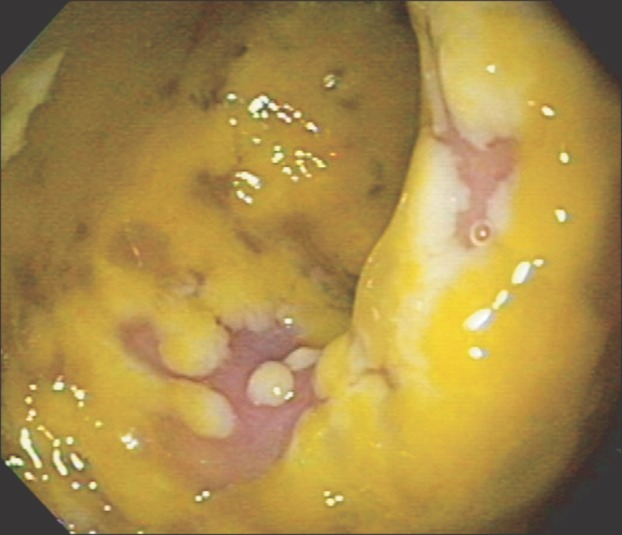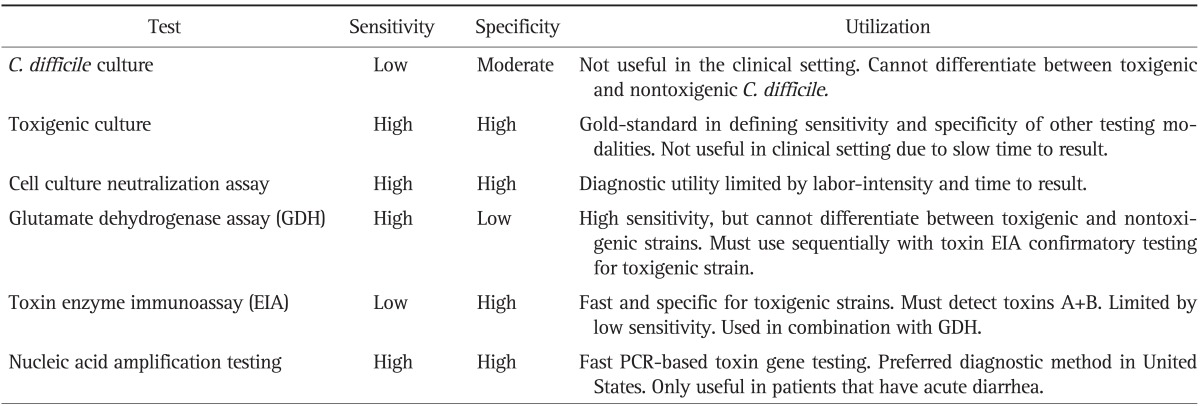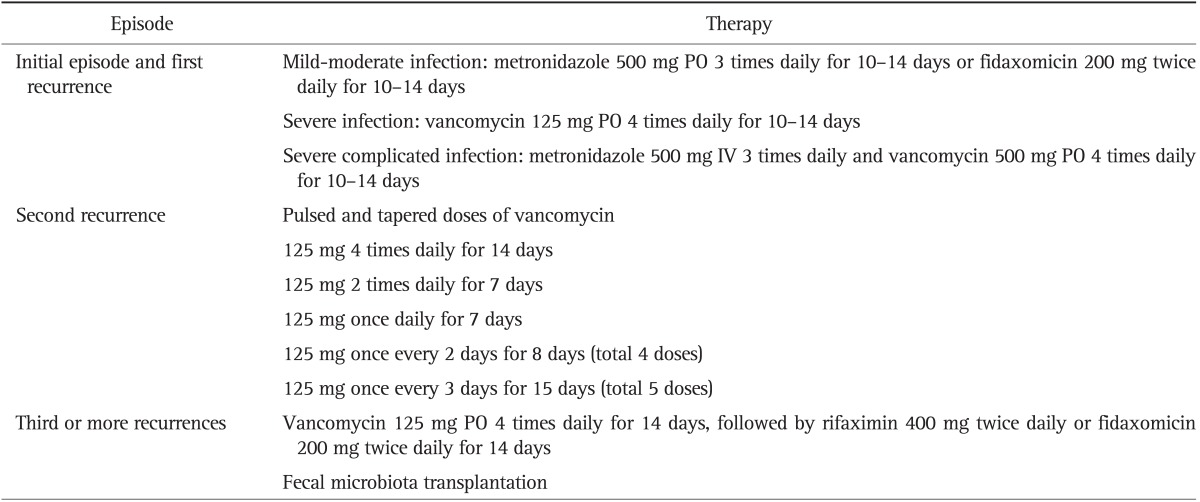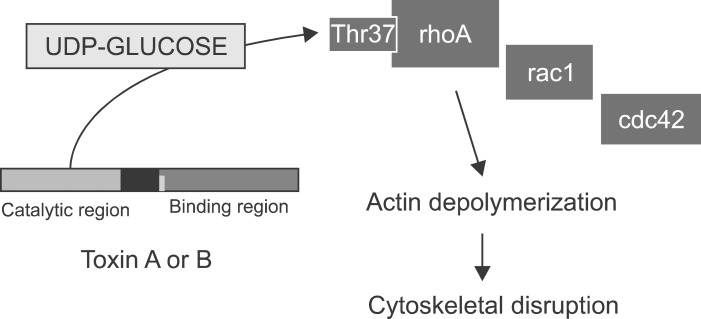Abstract
Clostridium difficile, an anaerobic toxigenic bacterium, causes a severe infectious colitis that leads to significant morbidity and mortality worldwide. Both enhanced bacterial toxins and diminished host immune response contribute to symptomatic disease. C. difficile has been a well-established pathogen in North America and Europe for decades, but is just emerging in Asia. This article reviews the epidemiology, microbiology, pathophysiology, and clinical management of C. difficile. Prompt recognition of C. difficile is necessary to implement appropriate infection control practices.
Keywords: Clostridium difficile, Epidemiology, Review, Asia
INTRODUCTION
Clostridium difficile is a fastidious, gram-positive, spore-forming bacterium responsible for infectious diarrhea and pseudomembranous colitis with significant morbidity and mortality. Patients at highest risk for C. difficile infection include hospitalized individuals >65 years old with recent antibiotic exposure. Risk factors for C. difficile in these individuals include depletion of protective gut flora by antibiotics1-3 and diminished immune response to C. difficile due to age and medical comorbidities.4,5 Most epidemics occur in the hospital setting and in long-term care facilities,6,7 but outpatient acquisition is also described. With the emergence of hypervirulent strains in both North America and Europe, the impact of C. difficile has broadened to affect a growing community-based population and younger individuals, even without previous exposure to antibiotics.8 Though historically a rare entity in Asia, this pathogen can spread quickly and will likely grow in frequency in areas currently considered to be low prevalence. This article describes the pathophysiology and clinical aspects of C. difficile infection, and reviews its emergence in Asia.
MICROBIOLOGY
C. difficile colonizes the large intestine of humans and domestic and wild mammals. Both toxigenic and nontoxigenic strains exist, but only toxigenic forms produce disease in humans. Pathogenicity is dependent on the presence of one or both of two closely related diarrhea-producing toxins, named toxin A (TcdA) and toxin B (TcdB).8 All toxigenic strains to date contain TcdB, with or without the presence of TcdA. TcdA and Tcd B share a common molecular mechanism of action: inactivation of Rho GTPases through enzymatic glucosylation of a conserved threonine residue. This pathway leads to actin depolymerization and cell death, and stimulates an inflammatory cascade that exacerbates tissue damage, diarrhea, and pseudomembranous colitis (Fig. 1).9,10 A third pathogenic toxin, binary toxin, is produced by some strains of C. difficile. This toxin has been shown to enhance virulence of C. difficile through irreversible adenosine diphosphate-ribosylation of actin, inducing the formation of long host-cell microtubule protrusions that facilitate bacterial attachment.11
Fig. 1.
Clostridium difficile toxins A and B monoglucosylate Rho GTPases. In the cytosol, the catalytic regions of toxin A and B glucosylate target Rho GTPases at the threonine residue (Thr), leading to disaffiliation of the actin cytoskeleton and eventual cell apoptosis.
PATHOPHYSIOLOGY
The ability of C. difficile to cause enteritis is based upon two host features: colonization resistance and immune response to C. difficile. The large intestine is protected from invasive pathogens by indigenous flora composed of approximately 4,000 bacterial species,12 collectively called the fecal microbiome. These microbes collectively provide colonization resistance against pathogenic species through competition for essential nutrients and attachment sites to the gut wall.13 Antibiotics disrupt the barrier microflora and diminish colonization resistance, thereby providing a niche for colonization by intestinal pathogens.1-3 Reduction of Bacteroides and Firmicutes phyla by antibiotics appears to be particularly important in the pathophysiology of C. difficile.14
The fecal flora of the newborn and infant lacks colonization resistance. As a result, 60% to 70% of healthy infants are asymptomatic carriers of C. difficile during the first 12 months of life.15 During this infantile carrier state, serum immunoglobulin G (IgG) and IgA antitoxins first appear and protect against subsequent C. difficile disease. These antibodies may persist and bind C. difficile toxins in the lumen to prevent diarrhea and colitis. Kyne et al.4 reported that serum antitoxin A IgG was higher in hospitalized patients who remained asymptomatic following C. difficile colonization, compared to those who developed acute infection.
Moreover, patients who mounted an appropriate antibody response during an initial episode of C. difficile infection were at decreased risk for recurrent infection.5 Conversely, Solomon et al.16 demonstrated that patients with a low serum antitoxin A IgG were significantly more likely to die during the first 30 days of infection. Advanced age, malnutrition, female gender, and medical comorbidities tend to diminish host protective response to C. difficile in adults,2 and may be associated with more severe infection.
EPIDEMIOLOGY
The geographic distribution of prevalent C. difficile strains is shown in Table 1. In 2003, the North American Pulse Field type 1 (NAP1)/ribotype 027 strain emerged as a source of C. difficile epidemics in Canada and the United States. This strain contains a mutation in the C. difficile toxin inhibitory gene tcdC, leading to increased toxin A and B production.17-19 It also produces binary toxin. Due to these virulence factors, the 027 strain has been associated with higher morbidity, recurrence rates, and presence in the community. From 1998 to 2009, the number of United States hospitalizations with a principal diagnosis of C. difficile infection increased from 25,200 to 110,600, reaching a plateau from 2008 to 2009.20 Similar to ribotype 027 in North America, ribotype 078 has been on the rise in Europe since 2005. This strain is also associated with increased community-acquired disease, younger age, and lack of preceding antibiotic therapy.21
Table 1.
Distribution of Prevalent Clostridium difficile Ribotypes

In Asia, C. difficile is reported as a low prevalence hospital pathogen, and its true prevalence remains unknown. A Korean study of 17 hospitals in 2008 found an increase in incidence from 1.7 cases/1,000 adult admissions in 2004 to 2.7 cases/1,000 adult admissions,22 considerably lower than the rate of 8.75 cases/1,000 adult admissions in United States hospitals over the same period.20 A 2007 to 2008 study in a single hospital in Shanghai, China found a similar incidence of C. difficile infection of 1.7 cases/1,000 admissions.23 Though ribotype 027 is quite rare in Asia, variant tdcA-/tcdB+ ribotype 017 has emerged as the predominant strain in east Asia, accounting for between 23% and 48% of toxigenic strains in Korea,24,25 China,26,27 Japan, and Taiwan. Ribotype 018 has been responsible for C. difficile outbreaks in Tokyo and Korea.28 Speciation of C. difficile in Hong Kong has revealed toxinotypes unique to east Asia. For example, Cheng et al.29 reported that of 345 C. difficile isolates, ribotype 002 was the most prevalent, representing 10.1% of strains, with ribotype 017 representing only 0.6% of strains. Moreover, 70% of strains did not belong to any of the 23 ribotypes prevalent in North America and Europe, and 11.6% were nontypable.29
A prospective study of Indian patients with acute diarrhea in 2012 demonstrated C. difficile in 8% of hospitalized patients and in 1.3% of outpatients.30 C. difficile was identified in 29% of patients with antibiotic associated diarrhea in Pakistan.31 Surveys of hospitalized patients in Singapore reported a prevalence of 3.0 to 6.6 active C. difficile cases per 10,000 inpatient days.32,33 In Malaysia and Thailand, recent reports suggest that C. difficile is more prevalent than previously appreciated, with rates of toxin A and B positivity of 14%34 and 44% to 46%,35 respectively, in patients with antibiotic-associated diarrhea. A recent report from the Philippines demonstrated that 44% of colitis cases were C. difficile positive, representing a paradigm shift as most cases in that country were previously attributed to amoebic or parasitic infections.36
CLINICAL PRESENTATION
The clinical presentation of C. difficile ranges across a wide spectrum from asymptomatic carrier state to toxic megacolon. Typical signs and symptoms of acute C. difficile infection include watery diarrhea (≥3 unformed stools/24 hours), anorexia, nausea, and leukocytosis with a neutrophilic predominance. Disease severity is used to guide antibiotic therapy.37 Disease is characterized as severe if associated with hypoalbuminemia (<3 g/dL), and leukocytosis exceeding 15,000 cells/mm3 or abdominal tenderness.38 Immunocompromised state, presence of inflammatory bowel disease,39-41 and acute kidney injury42 related to C. difficile also portend a worse prognosis and should be treated as severe in practice. The presence of associated leukocytosis above 35,000 cells/mm3, fever, hypotension, mental status changes, elevated serum lactate levels >2.2 mmol/L, end-organ failure, or admission to the Intensive Care Unit, define severe-complicated disease,38 with predicted 20% to 30% mortality. Rarely, C. difficile may result in an ileus with abdominal distention but little to no diarrhea. This presentation tends to herald a more severe course and should also be treated as severe-complicated disease.38
DIAGNOSIS
The diagnosis of C. difficile infection is based on the presence of typical signs and symptoms, in addition to identification of C. difficile organisms/toxin in stool or pseudomembranous colitis on colonoscopy (Fig. 2). Several laboratory tests are available for the diagnosis of C. difficile (Table 2). Nucleic acid amplification tests are most commonly employed in the United States, as they have the highest sensitivity and specificity, and provide quick results. A step-wise approach using a screening glutamate dehydrogenase assay followed serially by confirmatory immunotesting for toxins A and B may also be employed for diagnosis, but has lower sensitivity than polymerase chain reaction-based testing.38 Toxin-based testing should always include both toxin A and B, as the predominant ribotypes in Asia are toxin A negative.24,43
Fig. 2.

Pseudomembranous colitis. Appearance of pseudomembranes on colonoscopy confirms the diagnosis of Clostridium difficile, though is not required for diagnosis.
Table 2.
Utility of Stool Laboratory Tests for Clostridium difficile Infection

PCR, polymerase chain reaction.
PREVENTION
C. difficile is spread via the fecal-oral route by ingestion of acid-resistant spores. Therefore, appropriate hand-hygiene of healthcare workers by washing with soap and water to help remove spores and isolation of patients with acute diarrhea can limit spread in the hospital. Much effort has been focused on patient therapies to prevent symptomatic disease. Probiotics are generally well-tolerated and have been found in a recent Cochrane review including 23 randomized controlled trials to be associated with decreased incidence of C. difficile-associated diarrhea.44 Novel C. difficile vaccines based on inactived toxins A and B are also currently in development, and have been shown in early clinical trials to diminish the effects of C. difficile through enhancement of antitoxin A and B response.45-48
TREATMENT
The approach to treatment of C. difficile is outlined in Table 3. The inciting antibiotics should be stopped if possible to allow regeneration of the normal gut microflora, and an antibiotic with activity against C. difficile should be started. Initial therapies based on severity of disease include metronidazole for mild-moderate disease, vancomycin for severe disease, or a combination of the two for severe-complicated disease.8 All antibiotics are given orally, with the exception of metronidazole, which is active by the intravenous route owing to an active enterohepatic circulation.8 In 2011, fidaxomicin was shown to be non-inferior to vancomycin for the first or second episode of C. difficile49,50 and was approved in the United States for the treatment of mild-to-moderate C. difficile. The major advantage of fidaxomicin is its lower recurrence rate (15.4%) as compared to vancomycin (25.3%).50 However, widespread use of this antibiotic has been constrained by both cost51 and limited trial data. Treatment for the first episode of recurrent C. difficile is identical to that for initial treatment. Antibiotic therapies for subsequent recurrences include prolonged pulse-dosed vancomycin tapers, with an additional 14 days of rifaximin52 or fidaxomicin53 following the vancomycin taper (Table 3). Fecal microbiota tranpslantation, by which donor feces is infused into a patient's gastrointestinal lumen, results in a cure rate of approximately 90% in recurrent C. difficile infection.54 In the first randomized controlled trial of stool transplantation for recurrent C. difficile, van Nood et al.55 recently demonstrated that duodenal infusion of healthy donor feces was significantly more likely to result in cure (81%) than vancomycin with bowel lavage (31%) or vancomycin alone (23%) for the treatment of recurrent C. difficile. Fecal transplant is becoming the preferred treatment for patients with multiple recurrences of C. difficile infection.
Table 3.
Treatment of Clostridium difficile Infection

Adapted from Kelly CP, et al. N Engl J Med 2008;359:1932-1940, with permission from Massachusetts Medical Society.8
PO, orally; IV, intravenously.
SUMMARY
C. difficile, a pathogen responsible for severe infectious colitis that leads to significant morbidity and mortality worldwide, has established a foothold in Asia. The recent uptrend in C. difficile prevalence with increasingly pathogenic strains in North America and Europe likely heralds a similar pattern in Asia over time. Though testing for C. difficile is common in some parts of Asia, the paucity of literature supports the need for further clinical and laboratory awareness of this disease. Prompt recognition of this pathogen will support the essential development of infection control practices to thwart the propagation of C. difficile in Asia.
Footnotes
No potential conflict of interest relevant to this article was reported.
References
- 1.Edlund C, Nord CE. Effect of quinolones on intestinal ecology. Drugs. 1999;58(Suppl 2):65–70. doi: 10.2165/00003495-199958002-00013. [DOI] [PubMed] [Google Scholar]
- 2.Johnson S. Recurrent Clostridium difficile infection: a review of risk factors, treatments, and outcomes. J Infect. 2009;58:403–410. doi: 10.1016/j.jinf.2009.03.010. [DOI] [PubMed] [Google Scholar]
- 3.Pépin J, Saheb N, Coulombe MA, et al. Emergence of fluoroquinolones as the predominant risk factor for Clostridium difficile-associated diarrhea: a cohort study during an epidemic in Quebec. Clin Infect Dis. 2005;41:1254–1260. doi: 10.1086/496986. [DOI] [PubMed] [Google Scholar]
- 4.Kyne L, Warny M, Qamar A, Kelly CP. Asymptomatic carriage of Clostridium difficile and serum levels of IgG antibody against toxin A. N Engl J Med. 2000;342:390–397. doi: 10.1056/NEJM200002103420604. [DOI] [PubMed] [Google Scholar]
- 5.Kyne L, Warny M, Qamar A, Kelly CP. Association between antibody response to toxin A and protection against recurrent Clostridium difficile diarrhoea. Lancet. 2001;357:189–193. doi: 10.1016/S0140-6736(00)03592-3. [DOI] [PubMed] [Google Scholar]
- 6.Johnson S, Clabots CR, Linn FV, Olson MM, Peterson LR, Gerding DN. Nosocomial Clostridium difficile colonisation and disease. Lancet. 1990;336:97–100. doi: 10.1016/0140-6736(90)91605-a. [DOI] [PubMed] [Google Scholar]
- 7.Simor AE. Diagnosis, management, and prevention of Clostridium difficile infection in long-term care facilities: a review. J Am Geriatr Soc. 2010;58:1556–1564. doi: 10.1111/j.1532-5415.2010.02958.x. [DOI] [PubMed] [Google Scholar]
- 8.Kelly CP, LaMont JT. Clostridium difficile: more difficult than ever. N Engl J Med. 2008;359:1932–1940. doi: 10.1056/NEJMra0707500. [DOI] [PubMed] [Google Scholar]
- 9.Vedantam G, Clark A, Chu M, McQuade R, Mallozzi M, Viswanathan VK. Clostridium difficile infection: toxins and non-toxin virulence factors, and their contributions to disease establishment and host response. Gut Microbes. 2012;3:121–134. doi: 10.4161/gmic.19399. [DOI] [PMC free article] [PubMed] [Google Scholar]
- 10.Pothoulakis C, Lamont JT. Microbes and microbial toxins: paradigms for microbial-mucosal interactions II. The integrated response of the intestine to Clostridium difficile toxins. Am J Physiol Gastrointest Liver Physiol. 2001;280:G178–G183. doi: 10.1152/ajpgi.2001.280.2.G178. [DOI] [PubMed] [Google Scholar]
- 11.Schwan C, Stecher B, Tzivelekidis T, et al. Clostridium difficile toxin CDT induces formation of microtubule-based protrusions and increases adherence of bacteria. PLoS Pathog. 2009;5:e1000626. doi: 10.1371/journal.ppat.1000626. [DOI] [PMC free article] [PubMed] [Google Scholar]
- 12.Brandt LJ. American Journal of Gastroenterology Lecture: intestinal microbiota and the role of fecal microbiota transplant (FMT) in treatment of C. difficile infection. Am J Gastroenterol. 2013;108:177–185. doi: 10.1038/ajg.2012.450. [DOI] [PubMed] [Google Scholar]
- 13.Nord CE, Kager L, Heimdahl A. Impact of antimicrobial agents on the gastrointestinal microflora and the risk of infections. Am J Med. 1984;76(5A):99–106. doi: 10.1016/0002-9343(84)90250-x. [DOI] [PubMed] [Google Scholar]
- 14.Chang JY, Antonopoulos DA, Kalra A, et al. Decreased diversity of the fecal microbiome in recurrent Clostridium difficile-associated diarrhea. J Infect Dis. 2008;197:435–438. doi: 10.1086/525047. [DOI] [PubMed] [Google Scholar]
- 15.Jangi S, Lamont JT. Asymptomatic colonization by Clostridium difficile in infants: implications for disease in later life. J Pediatr Gastroenterol Nutr. 2010;51:2–7. doi: 10.1097/MPG.0b013e3181d29767. [DOI] [PubMed] [Google Scholar]
- 16.Solomon K, Martin AJ, O'Donoghue C, et al. Mortality in patients with Clostridium difficile infection correlates with host pro-inflammatory and humoral immune responses. J Med Microbiol. 2013;62(Pt 9):1453–1460. doi: 10.1099/jmm.0.058479-0. [DOI] [PubMed] [Google Scholar]
- 17.MacCannell DR, Louie TJ, Gregson DB, et al. Molecular analysis of Clostridium difficile PCR ribotype 027 isolates from Eastern and Western Canada. J Clin Microbiol. 2006;44:2147–2152. doi: 10.1128/JCM.02563-05. [DOI] [PMC free article] [PubMed] [Google Scholar]
- 18.McDonald LC, Killgore GE, Thompson A, et al. An epidemic, toxin gene-variant strain of Clostridium difficile. N Engl J Med. 2005;353:2433–2441. doi: 10.1056/NEJMoa051590. [DOI] [PubMed] [Google Scholar]
- 19.Warny M, Pepin J, Fang A, et al. Toxin production by an emerging strain of Clostridium difficile associated with outbreaks of severe disease in North America and Europe. Lancet. 2005;366:1079–1084. doi: 10.1016/S0140-6736(05)67420-X. [DOI] [PubMed] [Google Scholar]
- 20.US National Library of Medicine National Institutes of Health. Clostridium difficile infections (CDI) in hospital stays, 2009: statistical brief #124 [Internet] Bethesda: National Center for Biotechnology Information, U.S. National Library of Medicine; 2006. [cited 2013 Oct 23]. Available from: http://www.ncbi.nlm.nih.gov/pubmed/22574332. [Google Scholar]
- 21.Goorhuis A, Bakker D, Corver J, et al. Emergence of Clostridium difficile infection due to a new hypervirulent strain, polymerase chain reaction ribotype 078. Clin Infect Dis. 2008;47:1162–1170. doi: 10.1086/592257. [DOI] [PubMed] [Google Scholar]
- 22.Kim YS, Han DS, Kim YH, et al. Incidence and clinical features of Clostridium difficile infection in Korea: a nationwide study. Epidemiol Infect. 2013;141:189–194. doi: 10.1017/S0950268812000581. [DOI] [PMC free article] [PubMed] [Google Scholar]
- 23.Huang H, Fang H, Weintraub A, Nord CE. Distinct ribotypes and rates of antimicrobial drug resistance in Clostridium difficile from Shanghai and Stockholm. Clin Microbiol Infect. 2009;15:1170–1173. doi: 10.1111/j.1469-0691.2009.02992.x. [DOI] [PubMed] [Google Scholar]
- 24.Kim H, Riley TV, Kim M, et al. Increasing prevalence of toxin A-negative, toxin B-positive isolates of Clostridium difficile in Korea: impact on laboratory diagnosis. J Clin Microbiol. 2008;46:1116–1117. doi: 10.1128/JCM.01188-07. [DOI] [PMC free article] [PubMed] [Google Scholar]
- 25.Shin BM, Kuak EY, Yoo HM, et al. Multicentre study of the prevalence of toxigenic Clostridium difficile in Korea: results of a retrospective study 2000-2005. J Med Microbiol. 2008;57(Pt 6):697–701. doi: 10.1099/jmm.0.47771-0. [DOI] [PubMed] [Google Scholar]
- 26.Hawkey PM, Marriott C, Liu WE, et al. Molecular epidemiology of Clostridium difficile infection in a major Chinese hospital: an under recognised problem in Asia? J Clin Microbiol. 2013;51:3308–3313. doi: 10.1128/JCM.00587-13. [DOI] [PMC free article] [PubMed] [Google Scholar]
- 27.Dong D, Zhang L, Chen X, et al. Antimicrobial susceptibility and resistance mechanisms of clinical Clostridium difficile from a Chinese tertiary hospital. Int J Antimicrob Agents. 2013;41:80–84. doi: 10.1016/j.ijantimicag.2012.08.011. [DOI] [PubMed] [Google Scholar]
- 28.Kim J, Kang JO, Kim H, et al. Epidemiology of Clostridium difficile infections in a tertiary-care hospital in Korea. Clin Microbiol Infect. 2013;19:521–527. doi: 10.1111/j.1469-0691.2012.03910.x. [DOI] [PubMed] [Google Scholar]
- 29.Cheng VC, Yam WC, Lam OT, et al. Clostridium difficile isolates with increased sporulation: emergence of PCR ribotype 002 in Hong Kong. Eur J Clin Microbiol Infect Dis. 2011;30:1371–1381. doi: 10.1007/s10096-011-1231-0. [DOI] [PMC free article] [PubMed] [Google Scholar]
- 30.Ingle M, Deshmukh A, Desai D, et al. Clostridium difficile as a cause of acute diarrhea: a prospective study in a tertiary care center. Indian J Gastroenterol. 2013;32:179–183. doi: 10.1007/s12664-013-0303-8. [DOI] [PubMed] [Google Scholar]
- 31.Haider Naqvi SA, Chaudhry FF. Clostridium difficile postantibiotic diarrhoea diagnosis. J Coll Physicians Surg Pak. 2012;22:640–643. doi: 10.2012/JCPSP.640643. [DOI] [PubMed] [Google Scholar]
- 32.Hsu LY, Tan TY, Koh TH, et al. Decline in Clostridium difficile-associated disease rates in Singapore public hospitals, 2006 to 2008. BMC Res Notes. 2011;4:77. doi: 10.1186/1756-0500-4-77. [DOI] [PMC free article] [PubMed] [Google Scholar]
- 33.Lim PL, Barkham TM, Ling LM, Dimatatac F, Alfred T, Ang B. Increasing incidence of Clostridium difficile-associated disease, Singapore. Emerg Infect Dis. 2008;14:1487–1489. doi: 10.3201/eid1409.070043. [DOI] [PMC free article] [PubMed] [Google Scholar]
- 34.Hassan SA, Othman N, Idris FM, et al. Prevalence of Clostridium difficile toxin in diarhoeal stool samples of patients from a tertiary hospital in North Eastern Penisular Malaysia. Med J Malaysia. 2012;67:402–405. [PubMed] [Google Scholar]
- 35.Wongwanich S, Rugdeekha S, Pongpech P, Dhiraputra C. Detection of Clostridium difficile toxin A and B genes from stool samples of Thai diarrheal patients by polymerase chain reaction technique. J Med Assoc Thai. 2003;86:970–975. [PubMed] [Google Scholar]
- 36.Warren CA, Labio E, Destura R, Sevilleja JE, Jamias JD, Daez ML. Clostridium difficile and Entamoeba histolytica infections in patients with colitis in the Philippines. Trans R Soc Trop Med Hyg. 2012;106:424–428. doi: 10.1016/j.trstmh.2012.04.005. [DOI] [PubMed] [Google Scholar]
- 37.Zar FA, Bakkanagari SR, Moorthi KM, Davis MB. A comparison of vancomycin and metronidazole for the treatment of Clostridium difficile-associated diarrhea, stratified by disease severity. Clin Infect Dis. 2007;45:302–307. doi: 10.1086/519265. [DOI] [PubMed] [Google Scholar]
- 38.Surawicz CM, Brandt LJ, Binion DG, et al. Guidelines for diagnosis, treatment, and prevention of Clostridium difficile infections. Am J Gastroenterol. 2013;108:478–498. doi: 10.1038/ajg.2013.4. [DOI] [PubMed] [Google Scholar]
- 39.Berg AM, Kelly CP, Farraye FA. Clostridium difficile infection in the inflammatory bowel disease patient. Inflamm Bowel Dis. 2013;19:194–204. doi: 10.1002/ibd.22964. [DOI] [PubMed] [Google Scholar]
- 40.Issa M, Vijayapal A, Graham MB, et al. Impact of Clostridium difficile on inflammatory bowel disease. Clin Gastroenterol Hepatol. 2007;5:345–351. doi: 10.1016/j.cgh.2006.12.028. [DOI] [PubMed] [Google Scholar]
- 41.Nguyen GC, Kaplan GG, Harris ML, Brant SR. A national survey of the prevalence and impact of Clostridium difficile infection among hospitalized inflammatory bowel disease patients. Am J Gastroenterol. 2008;103:1443–1450. doi: 10.1111/j.1572-0241.2007.01780.x. [DOI] [PubMed] [Google Scholar]
- 42.Khanna S, Keddis MT, Noheria A, Baddour LM, Pardi DS. Acute kidney injury is an independent marker of severity in Clostridium difficile infection: a nationwide survey. J Clin Gastroenterol. 2013;47:481–484. doi: 10.1097/MCG.0b013e31826af6fd. [DOI] [PubMed] [Google Scholar]
- 43.Collins DA, Hawkey PM, Riley TV. Epidemiology of Clostridium difficile infection in Asia. Antimicrob Resist Infect Control. 2013;2:21. doi: 10.1186/2047-2994-2-21. [DOI] [PMC free article] [PubMed] [Google Scholar]
- 44.Goldenberg JZ, Ma SS, Saxton JD, et al. Probiotics for the prevention of Clostridium difficile-associated diarrhea in adults and children. Cochrane Database Syst Rev. 2013;5:CD006095. doi: 10.1002/14651858.CD006095.pub3. [DOI] [PubMed] [Google Scholar]
- 45.Donald RG, Flint M, Kalyan N, et al. A novel approach to generate a recombinant toxoid vaccine against Clostridium difficile. Microbiology. 2013;159(Pt 7):1254–1266. doi: 10.1099/mic.0.066712-0. [DOI] [PMC free article] [PubMed] [Google Scholar]
- 46.Foglia G, Shah S, Luxemburger C, Pietrobon PJ. Clostridium difficile: development of a novel candidate vaccine. Vaccine. 2012;30:4307–4309. doi: 10.1016/j.vaccine.2012.01.056. [DOI] [PubMed] [Google Scholar]
- 47.Leuzzi R, Spencer J, Buckley A, et al. Protective efficacy induced by recombinant Clostridium difficile toxin fragments. Infect Immun. 2013;81:2851–2860. doi: 10.1128/IAI.01341-12. [DOI] [PMC free article] [PubMed] [Google Scholar]
- 48.Riedmann EM. Human vaccines & immunotherapeutics: news. Hum Vaccin Immunother. 2013;9:2034–2037. doi: 10.4161/hv.26556. [DOI] [PubMed] [Google Scholar]
- 49.Cornely OA, Crook DW, Esposito R, et al. Fidaxomicin versus vancomycin for infection with Clostridium difficile in Europe, Canada, and the USA: a double-blind, non-inferiority, randomised controlled trial. Lancet Infect Dis. 2012;12:281–289. doi: 10.1016/S1473-3099(11)70374-7. [DOI] [PubMed] [Google Scholar]
- 50.Louie TJ, Miller MA, Mullane KM, et al. Fidaxomicin versus vancomycin for Clostridium difficile infection. N Engl J Med. 2011;364:422–431. doi: 10.1056/NEJMoa0910812. [DOI] [PubMed] [Google Scholar]
- 51.Bartsch SM, Umscheid CA, Fishman N, Lee BY. Is fidaxomicin worth the cost? An economic analysis. Clin Infect Dis. 2013;57:555–561. doi: 10.1093/cid/cit346. [DOI] [PMC free article] [PubMed] [Google Scholar]
- 52.Johnson S, Schriever C, Galang M, Kelly CP, Gerding DN. Interruption of recurrent Clostridium difficile-associated diarrhea episodes by serial therapy with vancomycin and rifaximin. Clin Infect Dis. 2007;44:846–848. doi: 10.1086/511870. [DOI] [PubMed] [Google Scholar]
- 53.Johnson S, Gerding DN. Fidaxomicin "chaser" regimen following vancomycin for patients with multiple Clostridium difficile recurrences. Clin Infect Dis. 2013;56:309–310. doi: 10.1093/cid/cis833. [DOI] [PubMed] [Google Scholar]
- 54.Burke KE, Lamont JT. Fecal transplantation for recurrent Clostridium difficile infection in older adults: a review. J Am Geriatr Soc. 2013;61:1394–1398. doi: 10.1111/jgs.12378. [DOI] [PubMed] [Google Scholar]
- 55.van Nood E, Vrieze A, Nieuwdorp M, et al. Duodenal infusion of donor feces for recurrent Clostridium difficile. N Engl J Med. 2013;368:407–415. doi: 10.1056/NEJMoa1205037. [DOI] [PubMed] [Google Scholar]



